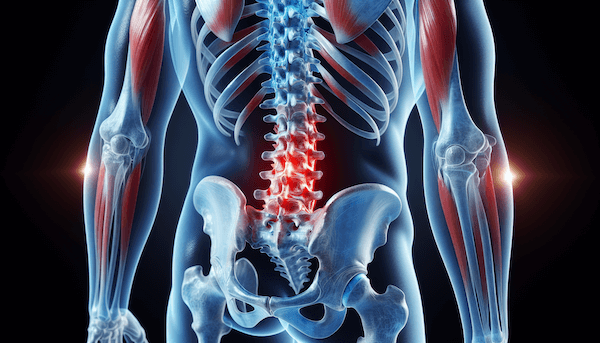Lumbar Fusion Surgery
Lumbar fusion surgery is a specialized procedure to permanently join two or more vertebrae in the lower spine, enhancing stability and alleviating pain.
Based in Sherman and Plano, Texas, Dr. Abdul Baker stands as a paragon in neurosurgery, renowned for his unparalleled expertise in minimally invasive spinal procedures.
At the forefront of neurosurgical innovation, Dr. Baker's approach to lumbar fusion surgery encapsulates a blend of meticulous skill and cutting-edge techniques.
Dr. Baker's adept use of minimally invasive methods not only ensures precision in treating spine-related ailments but also significantly reduces recovery time for patients.
This expertise is particularly beneficial for those seeking lumbar fusion surgery in Texas, as Dr. Baker's approach prioritizes both the efficacy of the surgery and the comfort of the patient.
Trust in Dr. Baker's experienced hands translates into a journey toward alleviating spinal discomfort with the utmost care and professionalism.
Request an Appointment
Understanding Lumbar Fusion Surgery
Lumbar fusion is a term that is often heard but not always fully understood, is a surgical procedure aimed at stabilizing the lower spine. The lumbar region of the spine, crucial for supporting much of the body's weight, is susceptible to various degenerative conditions.
In lumbar fusion, two or more vertebrae in the lumbar spine are permanently joined, or fused, eliminating the motion between them. This fusion is achieved through the placement of bone graft material, which, over time, leads to bone healing and the formation of a single, solid bone.

When Is Lumbar Fusion Necessary?
Lumbar fusion becomes a necessary consideration in several spinal conditions. The common ailments leading to this procedure include:
Degenerative Disc Disease
This condition, stemming from the natural aging process, involves the breakdown of intervertebral discs, leading to pain and instability.
Spondylolisthesis
A condition where one vertebra slips over the adjacent one, often causing severe pain and nerve compression.
Spinal Stenosis
The narrowing of the spinal canal, which can put pressure on the spinal cord and nerves, leading to pain and mobility issues.
Lumbar Scoliosis
An abnormal curvature of the spine, which in severe cases, can lead to pain and functional difficulties.
Chronic Low Back Pain
In cases where conservative treatments and physical therapy or exercises for lower back pain have failed, and the pain is attributed to specific spinal segments, lumbar fusion might be recommended.
Typical Patient Profiles for Lumbar Fusion
Patients considered for lumbar fusion often share similar profiles, we tend to find it more commonly employed for middle aged or elderly patients, this is usually due to the degenerative changes over time which may be compounded by lifestyle factors such as diet, poor exercise regime and others.
Patients who have previously undergone spine surgery which have proved unsuccessful are another cohort when it comes to lumbar spinal fusion. This might also be the choice for patients whose previous spine surgery is causing pain, which sometimes manifests as neck pain or back pain, and for those people successful lumbar fusion surgery acts to not only restore stability but also brings pain relief and higher quality of life.
Chronic pain is a common factor, this may not always be caused by previous spine surgery, persistent back pain can act to limit motion and flexibility, it almost always brings about a marked decline in quality of life that only increases with age.
Patients who exhibit these symptoms can be candidates for lumbar fusion, a systematic review of the underlying causes is a prerequisite for any treatment recommended by an expert neurosurgeon like Dr. Baker, whose treatment protocol and medical advice is based on intuitive understanding of the interplay between the spinal column, spinal cord, nerve roots, facet joints, pelvic bone, spinal bones and the way in which fusion heals after surgical procedures to provide the proper alignment.
The Process of Lumbar Fusion Surgery
Overview of Lumbar Fusion
Lumbar fusion is a complex surgical procedure designed to stabilize the spine by fusing two or more vertebral bones. This process is critical for patients experiencing severe spinal conditions that have not responded to conservative treatments. The procedure aims to restore stability, alignment, and alleviate pain in the lumbar spine.
Minimally Invasive Techniques in Lumbar Fusion
In recent advancements, lumbar fusion surgery often employs minimally invasive techniques. These methods reduce trauma to soft tissues, minimize blood loss, and promote faster recovery. Minimally invasive lumbar interbody fusion, for instance, involves smaller incisions and less disruption of the spinal muscles and surrounding soft tissues.
Types of Lumbar Fusion Surgeries
Lumbar fusion encompasses several types, each targeting specific spinal issues:
- Anterior Lumbar Interbody Fusion (ALIF)This technique involves approaching the spine from the front, removing the damaged intervertebral disc, and replacing it with an implant or bone graft. It allows for direct decompression of the spinal nerves without disturbing the spinal muscles and nerves at the back. Each disc plays a role in protecting your spinal nerve.
- Posterior Lumbar Interbody Fusion (PLIF)PLIF accesses the lumbar spine from the back. It involves removing the disc from between two spinal bones and inserting bone graft material. This procedure is beneficial for addressing issues like spinal stenosis and spondylolisthesis.
- Transforaminal Lumbar Interbody Fusion (TLIF)Similar to PLIF, TLIF involves a posterior approach but from a slightly different angle, allowing for better decompression of nerve roots and preservation of spinal stability.
Bone Grafting in Lumbar Fusion
A critical component of lumbar fusion is the use of bone graft material. Bone grafts, harvested either from the patient’s pelvic bone or a bone bank, are placed at the fusion site to facilitate bone healing and bony fusion. Over time, the graft material fuses with the vertebral bones, forming a solid bone mass.
Spinal Nerves and Blood Vessels Considerations
Special care is taken during lumbar fusion to protect the spinal nerves and blood vessels. The choice between anterior spinal fusion and posterior spinal fusion depends on the location of nerve compression and the area requiring stabilization. In both anterior and posterior approaches, meticulous techniques are employed to minimize the risk of damage to the spinal nerves and blood vessels.
Incorporating Advanced Technologies
Advanced technologies such as spinal implants and bone grafting materials are integral to lumbar fusion surgeries.
These tools enhance the efficacy of the procedure, ensuring proper alignment and stabilization of the lumbar spine.
The use of these technologies in lumbar interbody fusion, be it ALIF, PLIF, or TLIF, significantly improves the outcomes and success rates of the surgery.
The lumbar fusion process, particularly when performed using minimally invasive techniques, offers a comprehensive solution for complex spinal conditions. With the focus on patient safety and surgical precision, lumbar fusion surgeries like ALIF, PLIF, and TLIF have evolved to become more effective, ensuring better outcomes for patients suffering from debilitating spinal disorders.
Bone Grafts in Lumbar Fusion
The Crucial Role of Bone Grafts in Lumbar Fusion
Bone grafts play a pivotal role in the success of lumbar fusion surgeries. They are essential for facilitating the fusion process between vertebrae, promoting bone healing, and ensuring the stability of the spinal column. The integration of bone grafts into the fusion site encourages new bone growth, bridging the gap between adjacent vertebrae to form a single, solid bone.
Types of Bone Grafts
- Autografts (Pelvic Bone Grafts): Autografts involve harvesting bone from the patient’s own body, typically from the pelvic bone. This method is highly effective due to the graft's compatibility with the patient’s biology, reducing the risk of rejection and infection.
- Allografts (Bone Bank Grafts): Allografts are sourced from a bone bank and are typically used when a larger quantity of bone is required or to avoid additional surgery for graft harvesting. Despite being from a donor, these grafts have been treated to minimize rejection and disease transmission.
Medical Journals on Bone Grafts
Research published in respected medical journals, such as the Journal of Spine Surgery (J Spine Surg) and the Journal of Neurosurgery: Spine (J Neurosurg Spine), has highlighted the effectiveness of both autografts and allografts in lumbar fusion. Studies emphasize the importance of selecting the appropriate type of bone graft material based on individual patient needs and the specific requirements of the lumbar fusion procedure.
Frequently Asked Questions about
Lumbar Fusion Surgery
What are the benefits of Lumbar Fusion Surgery?
Pain Relief and Leg Pain Management
Lumbar fusion surgery is particularly effective in providing relief from chronic back and leg pain, often caused by conditions like degenerative disc disease or spondylolisthesis. By stabilizing the affected spinal segments, lumbar fusion alleviates pain triggered by spinal instability.
Improved Stability and Spinal Alignment
The procedure enhances the structural integrity of the spine. It corrects abnormal curvatures and misalignments, restoring proper spinal alignment. This structural correction not only improves the patient's posture but also aids in the long-term health and functionality of the spine.
What are the potential risks and complications of Lumbar Fusion Surgery?
What is the role of Physical Therapy in Recovery?
What lifestyle adjustments can be expected after the operation?


Dr. Baker specializes in neurosurgery, neurosurgical spine surgery, neurotrauma, brain tumors, spinal tumors, and peripheral nerve damage treatment.









